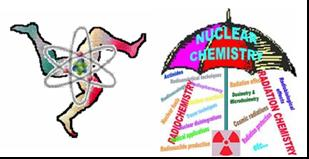Speaker
Prof.
Susanta Lahiri
(Saha Institute of Nuclear Physics)
Description
Amongst the various radioisotopes available or becoming available for application in nuclear medicine, 61Cu offers an appropriate selection for imaging and targeted radionuclide therapy, due to its superior nuclear properties including desirable half-life and ease of production. Earlier few methods were reported for separation and extraction of 64Cu using various analytical techniques. In this paper, we have attempted to develop a new separation method of no-carrier-added 61Cu from α-irradiated cobalt target. A pure cobalt foil of 21.2 mg/cm2 thickness was irradiated for 12 h with 30 MeV α-particle beam obtained from Variable Energy Cyclotron Centre (VECC), Kolkata, India with an average current 3 µA. The measurements of the activity of radionuclides were done by CANBERRA portable type HPGe detector of 1.9 keV resolutions at 1.33 MeV in conjugation with digital spectrum analyser (DSA 1000) and Genie 2000 software. A stock solution was prepared by dissolving the irradiated target material in 1:1 HNO3,,evaporated to dryness and finally dissolved it 0.01 M HCl. 60Co was spiked into the stock solution. Trioctylamine (TOA) was used as a liquid anion exchanger. In order to study the separation profile, 200 µL stock solution were added to 4 mL HCl of varying strength and was shaken for 10 min with the help of mechanical shaker with equal volume of 0.1 M TOA dissolved in cyclohexane. It was found that at 0.5 M TOA and 3 M HCl, 80% 61Cu was extracted into the organic phase with 25% contamination of bulk cobalt. Copper forms anionic complex [CuCl2]- and [CuCl4]2- which were responsible for preferable extraction of copper into the organic phase. The slight extraction of cobalt might be due to the formation of [CoCl4]- complex. However, the complete decontamination of cobalt is necessary, the study is on progress.
Primary author
Prof.
Susanta Lahiri
(Saha Institute of Nuclear Physics)
Co-author
Mr
Ajoy Mandal
(Saha Institute of Nuclear Physics)




